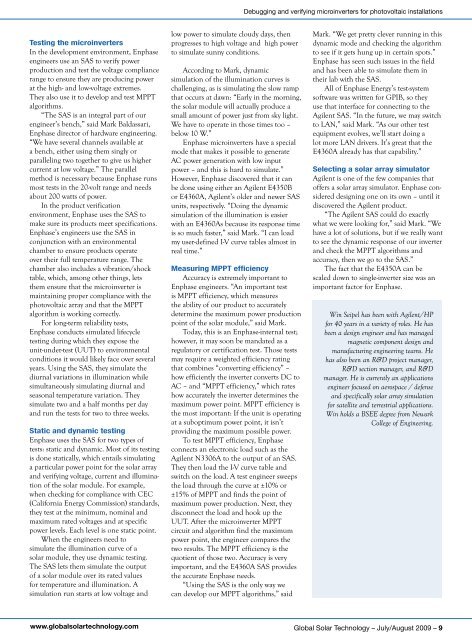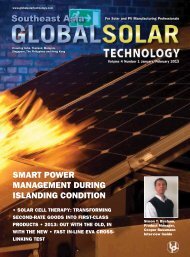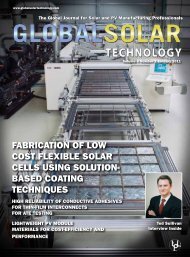download the PDF - Global Solar Technology
download the PDF - Global Solar Technology
download the PDF - Global Solar Technology
Create successful ePaper yourself
Turn your PDF publications into a flip-book with our unique Google optimized e-Paper software.
Debugging and verifying microinverters for photovoltaic installations<br />
Testing <strong>the</strong> microinverters<br />
In <strong>the</strong> development environment, Enphase<br />
engineers use an SAS to verify power<br />
production and test <strong>the</strong> voltage compliance<br />
range to ensure <strong>the</strong>y are producing power<br />
at <strong>the</strong> high- and low-voltage extremes.<br />
They also use it to develop and test MPPT<br />
algorithms.<br />
“The SAS is an integral part of our<br />
engineer’s bench,” said Mark Baldassari,<br />
Enphase director of hardware engineering.<br />
“We have several channels available at<br />
a bench, ei<strong>the</strong>r using <strong>the</strong>m singly or<br />
paralleling two toge<strong>the</strong>r to give us higher<br />
current at low voltage.” The parallel<br />
method is necessary because Enphase runs<br />
most tests in <strong>the</strong> 20-volt range and needs<br />
about 200 watts of power.<br />
In <strong>the</strong> product verification<br />
environment, Enphase uses <strong>the</strong> SAS to<br />
make sure its products meet specifications.<br />
Enphase’s engineers use <strong>the</strong> SAS in<br />
conjunction with an environmental<br />
chamber to ensure products operate<br />
over <strong>the</strong>ir full temperature range. The<br />
chamber also includes a vibration/shock<br />
table, which, among o<strong>the</strong>r things, lets<br />
<strong>the</strong>m ensure that <strong>the</strong> microinverter is<br />
maintaining proper compliance with <strong>the</strong><br />
photovoltaic array and that <strong>the</strong> MPPT<br />
algorithm is working correctly.<br />
For long-term reliability tests,<br />
Enphase conducts simulated lifecycle<br />
testing during which <strong>the</strong>y expose <strong>the</strong><br />
unit-under-test (UUT) to environmental<br />
conditions it would likely face over several<br />
years. Using <strong>the</strong> SAS, <strong>the</strong>y simulate <strong>the</strong><br />
diurnal variations in illumination while<br />
simultaneously simulating diurnal and<br />
seasonal temperature variation. They<br />
simulate two and a half months per day<br />
and run <strong>the</strong> tests for two to three weeks.<br />
Static and dynamic testing<br />
Enphase uses <strong>the</strong> SAS for two types of<br />
tests: static and dynamic. Most of its testing<br />
is done statically, which entails simulating<br />
a particular power point for <strong>the</strong> solar array<br />
and verifying voltage, current and illumination<br />
of <strong>the</strong> solar module. For example,<br />
when checking for compliance with CEC<br />
(California Energy Commission) standards,<br />
<strong>the</strong>y test at <strong>the</strong> minimum, nominal and<br />
maximum rated voltages and at specific<br />
power levels. Each level is one static point.<br />
When <strong>the</strong> engineers need to<br />
simulate <strong>the</strong> illumination curve of a<br />
solar module, <strong>the</strong>y use dynamic testing.<br />
The SAS lets <strong>the</strong>m simulate <strong>the</strong> output<br />
of a solar module over its rated values<br />
for temperature and illumination. A<br />
simulation run starts at low voltage and<br />
low power to simulate cloudy days, <strong>the</strong>n<br />
progresses to high voltage and high power<br />
to simulate sunny conditions.<br />
According to Mark, dynamic<br />
simulation of <strong>the</strong> illumination curves is<br />
challenging, as is simulating <strong>the</strong> slow ramp<br />
that occurs at dawn: “Early in <strong>the</strong> morning,<br />
<strong>the</strong> solar module will actually produce a<br />
small amount of power just from sky light.<br />
We have to operate in those times too –<br />
below 10 W.”<br />
Enphase microinverters have a special<br />
mode that makes it possible to generate<br />
AC power generation with low input<br />
power – and this is hard to simulate.”<br />
However, Enphase discovered that it can<br />
be done using ei<strong>the</strong>r an Agilent E4350B<br />
or E4360A, Agilent’s older and newer SAS<br />
units, respectively. “Doing <strong>the</strong> dynamic<br />
simulation of <strong>the</strong> illumination is easier<br />
with an E4360As because its response time<br />
is so much faster,” said Mark. “I can load<br />
my user-defined I-V curve tables almost in<br />
real time.”<br />
Measuring MPPT efficiency<br />
Accuracy is extremely important to<br />
Enphase engineers. “An important test<br />
is MPPT efficiency, which measures<br />
<strong>the</strong> ability of our product to accurately<br />
determine <strong>the</strong> maximum power production<br />
point of <strong>the</strong> solar module,” said Mark.<br />
Today, this is an Enphase-internal test;<br />
however, it may soon be mandated as a<br />
regulatory or certification test. Those tests<br />
may require a weighted efficiency rating<br />
that combines “converting efficiency” –<br />
how efficiently <strong>the</strong> inverter converts DC to<br />
AC – and “MPPT efficiency,” which rates<br />
how accurately <strong>the</strong> inverter determines <strong>the</strong><br />
maximum power point. MPPT efficiency is<br />
<strong>the</strong> most important: If <strong>the</strong> unit is operating<br />
at a suboptimum power point, it isn’t<br />
providing <strong>the</strong> maximum possible power.<br />
To test MPPT efficiency, Enphase<br />
connects an electronic load such as <strong>the</strong><br />
Agilent N3306A to <strong>the</strong> output of an SAS.<br />
They <strong>the</strong>n load <strong>the</strong> I-V curve table and<br />
switch on <strong>the</strong> load. A test engineer sweeps<br />
<strong>the</strong> load through <strong>the</strong> curve at ±10% or<br />
±15% of MPPT and finds <strong>the</strong> point of<br />
maximum power production. Next, <strong>the</strong>y<br />
disconnect <strong>the</strong> load and hook up <strong>the</strong><br />
UUT. After <strong>the</strong> microinverter MPPT<br />
circuit and algorithm find <strong>the</strong> maximum<br />
power point, <strong>the</strong> engineer compares <strong>the</strong><br />
two results. The MPPT efficiency is <strong>the</strong><br />
quotient of those two. Accuracy is very<br />
important, and <strong>the</strong> E4360A SAS provides<br />
<strong>the</strong> accurate Enphase needs.<br />
“Using <strong>the</strong> SAS is <strong>the</strong> only way we<br />
can develop our MPPT algorithms,” said<br />
Mark. “We get pretty clever running in this<br />
dynamic mode and checking <strong>the</strong> algorithm<br />
to see if it gets hung up in certain spots.”<br />
Enphase has seen such issues in <strong>the</strong> field<br />
and has been able to simulate <strong>the</strong>m in<br />
<strong>the</strong>ir lab with <strong>the</strong> SAS.<br />
All of Enphase Energy’s test-system<br />
software was written for GPIB, so <strong>the</strong>y<br />
use that interface for connecting to <strong>the</strong><br />
Agilent SAS. “In <strong>the</strong> future, we may switch<br />
to LAN,” said Mark. “As our o<strong>the</strong>r test<br />
equipment evolves, we’ll start doing a<br />
lot more LAN drivers. It’s great that <strong>the</strong><br />
E4360A already has that capability.”<br />
Selecting a solar array simulator<br />
Agilent is one of <strong>the</strong> few companies that<br />
offers a solar array simulator. Enphase considered<br />
designing one on its own – until it<br />
discovered <strong>the</strong> Agilent product.<br />
“The Agilent SAS could do exactly<br />
what we were looking for,” said Mark. “We<br />
have a lot of solutions, but if we really want<br />
to see <strong>the</strong> dynamic response of our inverter<br />
and check <strong>the</strong> MPPT algorithms and<br />
accuracy, <strong>the</strong>n we go to <strong>the</strong> SAS.”<br />
The fact that <strong>the</strong> E4350A can be<br />
scaled down to single-inverter size was an<br />
important factor for Enphase.<br />
Win Seipel has been with Agilent/HP<br />
for 40 years in a variety of roles. He has<br />
been a design engineer and has managed<br />
magnetic component design and<br />
manufacturing engineering teams. He<br />
has also been an R&D project manager,<br />
R&D section manager, and R&D<br />
manager. He is currently an applications<br />
engineer focused on aerospace / defense<br />
and specifically solar array simulation<br />
for satellite and terrestrial applications.<br />
Win holds a BSEE degree from Newark<br />
College of Engineering.<br />
www.globalsolartechnology.com<br />
<strong>Global</strong> <strong>Solar</strong> <strong>Technology</strong> – July/August 2009 – 9
















